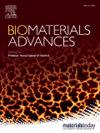5-氟尿嘧啶/姜黄素负载丝素水凝胶用于大肠癌的辅助治疗
IF 5.5
2区 医学
Q2 MATERIALS SCIENCE, BIOMATERIALS
Materials Science & Engineering C-Materials for Biological Applications
Pub Date : 2024-11-06
DOI:10.1016/j.bioadv.2024.214108
引用次数: 0
摘要
本研究以丝素(SF)为载体材料,包封姜黄素(CUR)和5-氟尿嘧啶(5-FU),形成高效的载药水凝胶。该方法将含有5-FU的SF溶液与溶解于丙酮(AC)的姜黄素溶液混合,形成粒径在77.87 nm至299.22 nm之间的复合载药纳米球,具有增强的渗透性和滞留性(EPR)作用,能够被动靶向实体肿瘤。纳米球形成后,将其分散到含有SF和聚乙二醇(PEG)的溶液中。凝胶化和去除PEG后,获得装载5-FU和CUR的SF水凝胶(5-FU/CUR@SF水凝胶)。结果表明,5-FU/CUR@SF水凝胶具有优异的释药性能,5-FU和CUR在400 h内的缓释率分别为59.66±3.76%和47.94±5.03%。用5-FU/CUR@SF水凝胶培养人结直肠癌细胞系HT-29和正常人结肠上皮细胞系NCM-460后,NCM-460细胞的凋亡率仅为17.38±1.98%,而HT-29细胞的凋亡率为72.31±2.18%,细胞存活率为59.77±0.55%。这些结果表明,5-FU/CUR@SF水凝胶对正常NCM-460细胞具有较低的细胞毒性,而对HT-29癌细胞具有显著且持续的抑制作用。综上所述,基于sf的载药复合水凝胶作为一种新的CRC辅助治疗策略具有很大的潜力。本文章由计算机程序翻译,如有差异,请以英文原文为准。
5-Fluorouracil/curcumin loaded silk fibroin hydrogel for the adjuvant therapy in colorectal cancer
This study employed silk fibroin (SF) as a carrier material to encapsulate curcumin (CUR) and 5-fluorouracil (5-FU), forming a highly effective drug-loaded hydrogel. The process involved mixing SF solution containing 5-FU with curcumin solution dissolved in acetone (AC), leading to the formation of composite drug-loaded nanospheres with particle sizes ranging from 77.87 nm to 299.22 nm, demonstrated enhanced permeability and retention (EPR) effects, enabling passive targeting of solid tumors. After the formation of the nanospheres, they were dispersed into a solution containing SF and polyethylene glycol (PEG). Following gelation and PEG removal, a SF hydrogel loaded with 5-FU and CUR (5-FU/CUR@SF hydrogel) was obtained. Results indicated that the 5-FU/CUR@SF hydrogel exhibited excellent drug release properties, with 5-FU and CUR achieving sustained release of 59.66 ± 3.76 % and 47.94 ± 5.03 %, respectively, over a 400-h of sustainable releasing period. Human colorectal cancer cell line (HT-29) and normal human colon epithelial cell line (NCM-460) were cultured with the 5-FU/CUR@SF hydrogel, resulting an apoptosis rate of only 17.38 ± 1.98 % for NCM-460 cells, whereas the apoptosis rate for HT-29 cells significantly increased to 72.31 ± 2.18 %, and its cell viability dropped to 59.77 ± 0.55 %. These findings suggest that the 5-FU/CUR@SF hydrogel exhibits low cytotoxicity toward normal NCM-460 cells, while exerting significant and sustained inhibitory effects on HT-29 cancer cells. In conclusion, the SF-based drug-loaded composite hydrogel holds great potential as a novel adjuvant therapeutic strategy for the treatment of CRC.
求助全文
通过发布文献求助,成功后即可免费获取论文全文。
去求助
来源期刊
CiteScore
17.80
自引率
0.00%
发文量
501
审稿时长
27 days
期刊介绍:
Biomaterials Advances, previously known as Materials Science and Engineering: C-Materials for Biological Applications (P-ISSN: 0928-4931, E-ISSN: 1873-0191). Includes topics at the interface of the biomedical sciences and materials engineering. These topics include:
• Bioinspired and biomimetic materials for medical applications
• Materials of biological origin for medical applications
• Materials for "active" medical applications
• Self-assembling and self-healing materials for medical applications
• "Smart" (i.e., stimulus-response) materials for medical applications
• Ceramic, metallic, polymeric, and composite materials for medical applications
• Materials for in vivo sensing
• Materials for in vivo imaging
• Materials for delivery of pharmacologic agents and vaccines
• Novel approaches for characterizing and modeling materials for medical applications
Manuscripts on biological topics without a materials science component, or manuscripts on materials science without biological applications, will not be considered for publication in Materials Science and Engineering C. New submissions are first assessed for language, scope and originality (plagiarism check) and can be desk rejected before review if they need English language improvements, are out of scope or present excessive duplication with published sources.
Biomaterials Advances sits within Elsevier''s biomaterials science portfolio alongside Biomaterials, Materials Today Bio and Biomaterials and Biosystems. As part of the broader Materials Today family, Biomaterials Advances offers authors rigorous peer review, rapid decisions, and high visibility. We look forward to receiving your submissions!

 求助内容:
求助内容: 应助结果提醒方式:
应助结果提醒方式:


